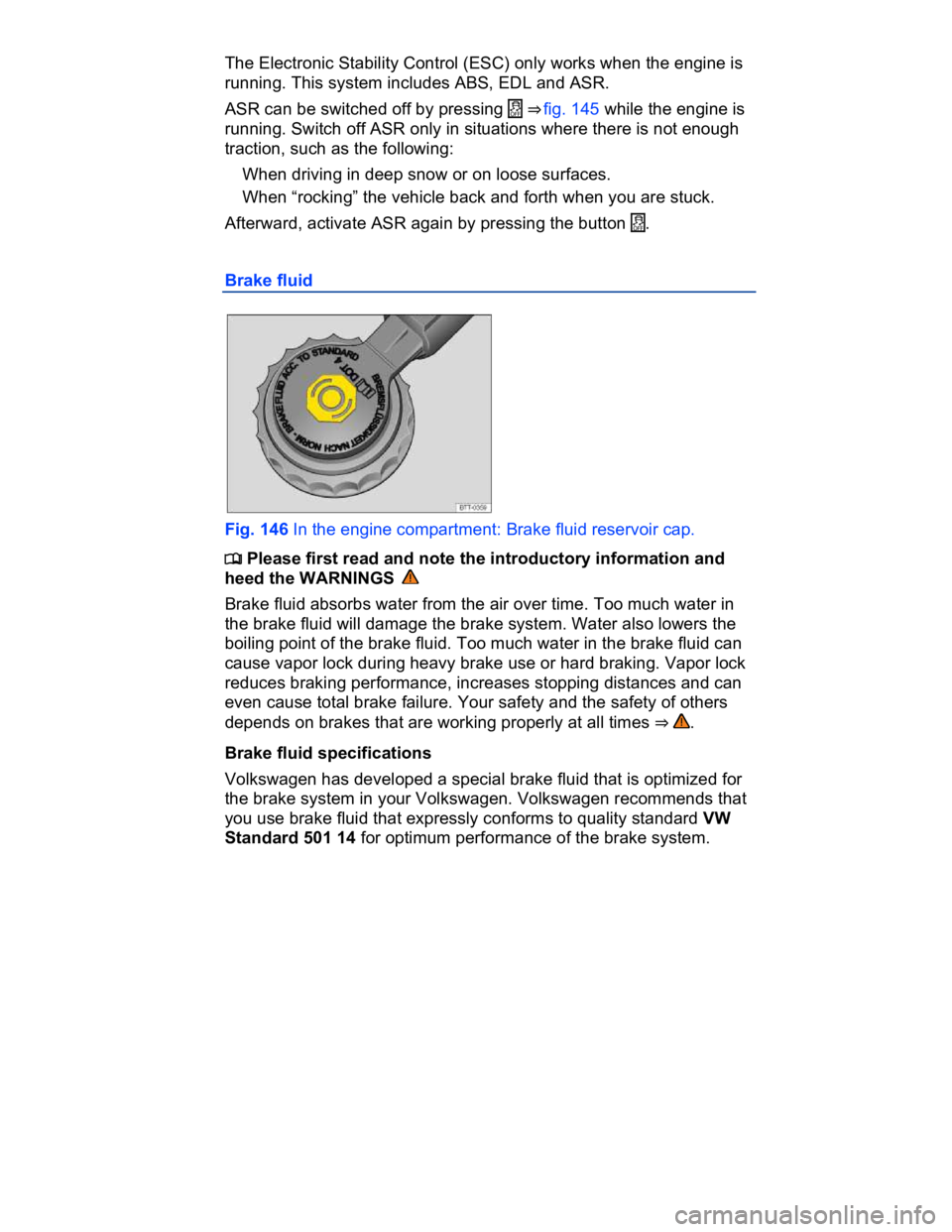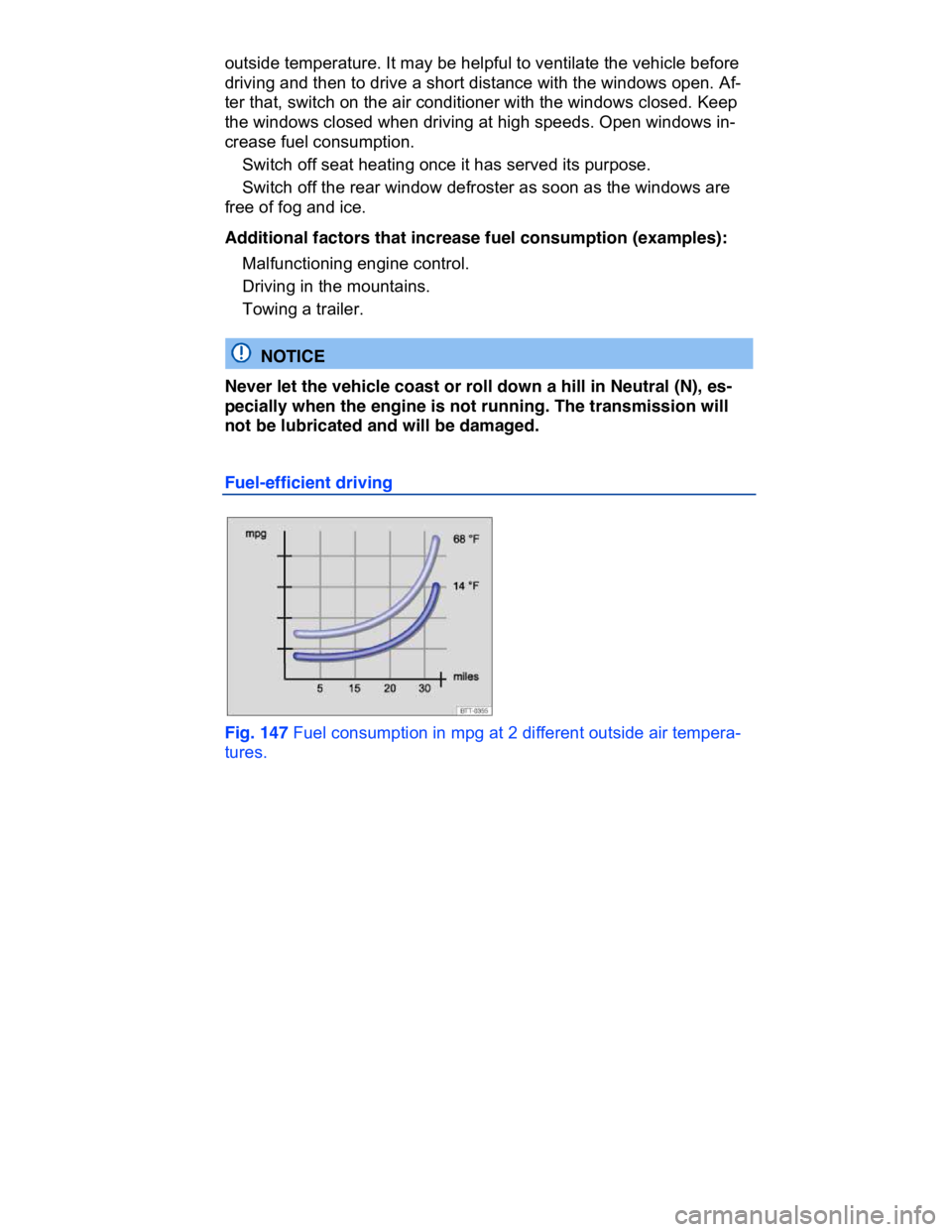2018 VOLKSWAGEN CC engine
[x] Cancel search: enginePage 345 of 578

WARNING
Wet brakes or brakes coated with ice or road salt react slower
and need longer stopping distances.
� Carefully apply the brakes to test them.
� Always dry brakes and clean off ice and salt coatings with a
few cautious brake applications when visibility, weather, road
and traffic conditions permit.
WARNING
Driving when the brake booster is not working increases stop-
ping distances and can cause accidents and serious personal
injuries.
� Never let the vehicle coast when the engine is switched off.
� If the brake booster is not working (such as when the vehicle
is being towed), a lot more pedal force is needed to slow down
and stop.
NOTICE
� Never “ride” the brakes by keeping your foot on the brake pe-
dal when you do not want to brake. Constant pressure on the
brake pedal can make the brakes overheat. Riding the brakes
will substantially reduce braking performance, increase stopping
distance, and can cause complete brake system failure.
� Before driving downhill, especially on hills that are long or
steep, always reduce speed and shift into lower gear (manual or
automatic transmission). This will let the vehicle use engine
braking and reduce the load on the brakes. Otherwise, the brake
system could overheat and possibly fail. Only use the brakes
when you need them to slow the vehicle down more or to stop.
When the front brakes are serviced, you should have the rear
brake pads inspected at the same time. The wear of all brake pads
should be visually checked regularly. The best way to check for brake
pad wear is to have your authorized Volkswagen dealer or authorized
Volkswagen Service Facility visually inspect the pads through the
Page 347 of 578

help keep the vehicle going in the intended direction. If you are travel-
ing at a speed that causes you to run off the road before ESC can
provide any assistance, you may not experience the benefits of ESC.
ESC includes and/or works together with the ABS, BAS, ASR, EDL,
and XDL systems (see below). ESC is switched on all the time. In
certain situations when you need less traction or additional traction
cannot be achieved, you can switch off ASR by pressing the �m button
⇒ fig. 145. Be sure to switch ASR on again when you no longer need
less traction.
Anti-Lock Brake System (ABS)
ABS helps to keep the wheels from locking up and helps to maintain
the driver's ability to steer and control the vehicle. This means the
vehicle is less likely to skid, even during hard braking:
� Push the brake pedal down hard and hold it there. Don't take your
foot off the pedal or reduce the force on the pedal!
� Do not “pump” the brake pedal or let up on it!
� Steer the vehicle while pushing down hard on the brake pedal.
� ABS stops working if you release or let up on the brake.
When ABS is doing its job, you will notice a slight vibration through
the brake pedal and hear a noise. ABS cannot shorten the stopping
distance under all conditions. The stopping distance may even be
longer, for instance, when driving on gravel or on newly fallen snow
covering an icy or slippery surface.
Brake Assist (BAS)
The Brake Assist System can help to reduce stopping distances. If
you press the brake pedal very quickly, BAS detects an emergency
situation. It then very quickly builds up full brake system pressure,
maximizing braking power and reducing the stopping distance. This
way, ABS can be activated more quickly and efficiently.
Do not reduce pressure on the brake pedal! BAS switches off auto-
matically as soon as you release or let up on the brake.
Anti-Slip Regulation (ASR)
ASR reduces engine power directed to spinning wheels and adjusts
power to the road conditions. Even under poor road conditions, ASR
can make it easier to get moving, accelerate, and climb hills.
Page 350 of 578

WARNING
The effectiveness of ESC can be significantly reduced if other
components and systems that affect vehicle dynamics, includ-
ing but not limited to brakes, tires, and other systems men-
tioned above, are not properly maintained or functioning.
� Always remember that vehicle alterations or modifications
can affect the functioning of the ABS, BAS, ASR, EDL, and ESC
systems.
� Changing the vehicle suspension or using an unapproved
tire/wheel combination can change the way the ABS, BAS, ASR,
EDL, and ESC systems work and reduce their effectiveness.
� The effectiveness of ESC is also determined by the tires fitted
⇒ Tires and wheels.
All 4 wheels must be equipped with identical tires in order for
ESC and ASR to work properly. Differences in the tread circumfer-
ence of the tires can cause the system to reduce the engine power
when it is not expected.
If ABS is not working, ESC, ASR, and EDL will also not work.
You may hear noises when these systems are active.
Switching Anti-Slip Regulation (ASR) on and off
Fig. 145 In the center console: Button for switching ASR on and off
manually.
�
Page 351 of 578

The Electronic Stability Control (ESC) only works when the engine is
running. This system includes ABS, EDL and ASR.
ASR can be switched off by pressing �m ⇒ fig. 145 while the engine is
running. Switch off ASR only in situations where there is not enough
traction, such as the following:
� When driving in deep snow or on loose surfaces.
� When “rocking” the vehicle back and forth when you are stuck.
Afterward, activate ASR again by pressing the button �m.
Brake fluid
Fig. 146 In the engine compartment: Brake fluid reservoir cap.
�
Page 352 of 578

Check the information on the container for the brake fluid you want to
use to make sure it meets the requirements for your vehicle.
Brake fluid that complies with VW Standard 501 14 can be pur-
chased from your authorized Volkswagen dealer or authorized
Volkswagen Service Facility.
If this special brake fluid is not available you may – under these cir-
cumstances – use another high quality brake fluid that complies with
U.S. Federal Motor Vehicle Safety Standard (FMVSS) 116 DOT 4 ⇒
.
Please note, however, that not all brake fluids that comply with U.S.
Federal Motor Vehicle Safety Standard FMVSS 116 DOT 4 have the
same chemical composition. Some of these brake fluids can contain
chemicals that could, over time, degrade or damage internal parts of
the vehicle’s brake system.
Volkswagen therefore recommends that you use brake fluid that ex-
pressly complies with VW Standard 501 14 for optimum brake sys-
tem performance over the long term.
Brake fluid level
The fluid level in the transparent brake fluid reservoir must always be
between the MIN and MAX marking ⇒ .
On some vehicles, engine components block the view of the brake
fluid reservoir and make it impossible to see the brake fluid level. If
you cannot clearly see the brake fluid level in the brake fluid reservoir,
please see an authorized Volkswagen dealer or authorized
Volkswagen Service Facility.
The brake fluid level drops slightly when the vehicle is being used as
the brake pads wear and the brakes are automatically adjusted.
Changing brake fluid
Brake fluid must be changed according to the service schedule in
your ⇒ Booklet Warranty and Maintenance. Have the brake fluid
checked by an authorized Volkswagen dealer or an authorized
Volkswagen Service Facility. Refill only with new brake fluid that
meets the standards listed above.
Page 356 of 578

Vehicles with gear recommendation aid in fuel efficient driving by in-
dicating the optimum time to shift gears.
Coasting
If you take your foot off the accelerator, fuel delivery to the engine is
interrupted, which lowers fuel consumption.
Therefore, when nearing a red stop light, for instance, allow the vehi-
cle to coast without using the accelerator. Press the clutch pedal and
release it only if the vehicle moving too slowly or the coasting dis-
tance is too long. The engine will then continue to run at idle.
In situations where the vehicle will be stopped for a longer period of
time, such as at a railroad crossing, physically switch off the engine.
Defensive driving and “flowing” with traffic
Frequent braking and acceleration increase fuel consumption signifi-
cantly. Just by driving defensively and keeping a sufficiently large
distance away from the vehicle in front of you can make up for the
speed fluctuations caused by taking your foot off the accelerator. Ac-
tive braking and accelerating is then not necessarily required.
Calm and smooth driving
Consistency is more important than speed. The more smoothly you
drive, the less fuel the vehicle consumes.
When driving on the highway or freeway, a constant, moderate speed
is more efficient and economical than constantly accelerating and
braking. Usually you can reach your destination just as quickly by
driving at a moderate, but steady speed.
The cruise control system can assist in maintaining a uniform driving
style.
Moderate use of extra electrical loads
Comfort inside the vehicle is nice and important, but it is important to
use them in an environmentally conscious manner.
Some devices can increase fuel consumption when activated (exam-
ples):
� Climate control system (air conditioner): If the air conditioner has to
produce starkly contrasting temperatures, it requires a large amount
of energy, which is generated by the engine. The temperature in the
vehicle should therefore not be extremely different from that of the
Page 357 of 578

outside temperature. It may be helpful to ventilate the vehicle before
driving and then to drive a short distance with the windows open. Af-
ter that, switch on the air conditioner with the windows closed. Keep
the windows closed when driving at high speeds. Open windows in-
crease fuel consumption.
� Switch off seat heating once it has served its purpose.
� Switch off the rear window defroster as soon as the windows are
free of fog and ice.
Additional factors that increase fuel consumption (examples):
� Malfunctioning engine control.
� Driving in the mountains.
� Towing a trailer.
NOTICE
Never let the vehicle coast or roll down a hill in Neutral (N), es-
pecially when the engine is not running. The transmission will
not be lubricated and will be damaged.
Fuel-efficient driving
Fig. 147 Fuel consumption in mpg at 2 different outside air tempera-
tures.
Page 359 of 578

Adjust the tire pressure
The proper tire pressure helps reduce rolling resistance as well as
fuel consumption.
When purchasing new tires, always make sure that the tires are opti-
mized for lower rolling resistance.
Use low viscosity engine oil
Fully “synthetic,” low viscosity engine oils that expressly comply with
Volkswagen oil quality standards reduce fuel consumption. Low vis-
cosity engine oils reduce the frictional resistance on the engine and
are distributed more evenly and quickly, particularly when cold-
starting the engine. The effect is particularly apparent in vehicles that
frequently travel short distances.
Always ensure the right engine oil level is maintained and keep to the
scheduled service intervals (engine oil changes).
Make sure the engine oil that you purchase expressly complies with
Volkswagen oil quality standards and is the oil approved by
Volkswagen for your vehicle.
Avoid unnecessary weight
The lighter the vehicle, the more economical and eco-friendly it will
be. For example, an extra 220 lbs (100 kg) of weight increases fuel
consumption by up to 1 pint per 60 miles (0.3 l/100 km).
Remove all unnecessary items and unnecessary dead weight from
the vehicle.
Remove unnecessary aftermarket components
The more aerodynamic the vehicle, the less fuel it will consume. Af-
termarket components such as bicycle racks reduce its aerodynamic
performance.
Therefore, remove unnecessary structures and unused rack systems,
particularly if planning to drive at higher speeds.